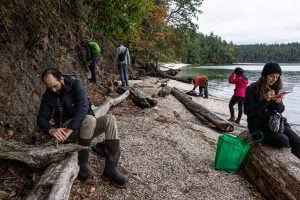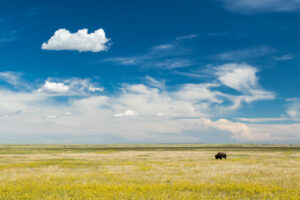
Environment
The sixth extinction
The planet is in the midst of drastic biodiversity loss that some experts think may be the next great species die-off. How did we get here and what can be done about it?
- 4895 words
- 20 minutes
Environment
Thanks to contributions from donors like Kruger Products, the Nature Conservancy of Canada is restoring and protecting some of Canada’s most valuable ecosystems

When you think of the Rocky Mountains, you likely don’t think of open grasslands and wetlands. And yet, in the valleys below the snow-capped peaks and glaciers that dominate our imagination lies an astonishing diversity of habitats that support a wide array of wildlife. This is especially true at the Kootenay River Ranch Conservation Area, which protects part of a critical wildlife corridor in a rapidly developing valley in the Rocky Mountain Trench in southeastern British Columbia. Here, thanks to the efforts of the Nature Conservancy of Canada (NCC) and its partners, crucial habitats are being protected and restored.
Located in East Kootenay, B.C., the Kootenay River Ranch Conservation Area is a crucial expanse of land that encompasses prime grassland and open forest habitat for hundreds of species, some of which are at risk. Bordered by the Rocky Mountains in the east and the Purcell Mountains in the west, the area is home to dozens of ecosystems essential to maintaining the life and beauty of the region.
NCC has been working to secure land in the Rocky Mountain Trench for nearly two decades. Since an initial acquisition in 2004, the organization has protected a total of 1,598 hectares at Kootenay River Ranch thanks to donations from valued partners like Kruger Products.
As Canada’s leading not-for-profit, private land conservation organization, NCC works to protect critical natural areas and the species that they sustain. On Kootenay River Ranch, NCC has been working to restore native habitats by removing non-native species and engaging in tree planting, open forest restoration and other habitat enhancement activities. As a primary goal of NCC, this type of ecosystem restoration allows species in the area to thrive in the environments they depend on.

Kootenay River Ranch is home to a number of distinct habitats that support a wide array of biodiversity, including bunchgrass savannah with areas of ponderosa pine, larch and Douglas-fir forest, and small wetlands. The savannah is a form of grasslands, which is one of the world’s most endangered ecosystems.
Kootenay River Ranch also falls within an identified grizzly bear linkage zone that runs from the Rockies to the Purcell Mountains. This makes the conservation area a critical corridor for highly mobile and migratory wildlife including the grizzly bear, which is listed as a species of special concern under the federal Species at Risk Act, and the threatened Lewis’s woodpecker.
By conserving private land, NCC is also helping endangered American badger populations, which are found in open forest ecosystems like the grasslands in East Kootenay. Private land conservation addresses a major threat to badgers: direct mortality caused by roads and collisions.
Creating functioning ecosystems also means bringing back the natural processes that shape them. The landscape around Kootenay River Ranch historically experienced periodic low-intensity wildfires, which prevented the open forests and grasslands from filling with trees. When settlers arrived in the area, communities suppressed these fires, and as settlement expanded throughout the 20th century, grasslands and open forest ecosystems turned into dense forests. By thinning these forests, NCC is bringing back the open forest and grassland savannah that was present hundreds of years ago. With more intact and functional ecosystems, the area is better adapted and resilient to the effects of climate change while providing habitat for many species.
NCC’s stewardship work at Kootenay River Ranch also involves controlling the spread of invasive species such as spotted knapweed and hound’s tongue. Second to habitat loss, invasive plants pose the largest threat to native biodiversity.
With a focus on improving the condition and integrity of grasslands and open forests in Kootenay River Ranch, NCC can better achieve conservation for the wildlife that depend on it.
Are you passionate about Canadian geography?
You can support Canadian Geographic in 3 ways:

Environment
The planet is in the midst of drastic biodiversity loss that some experts think may be the next great species die-off. How did we get here and what can be done about it?

Environment
As the impacts of global warming become increasingly evident, the connections to biodiversity loss are hard to ignore. Can this fall’s two key international climate conferences point us to a nature-positive future?

People & Culture
Naming leads to knowing, which leads to understanding. Residents of a small British Columbia island take to the forests and beaches to connect with their nonhuman neighbours

Environment
Environment and Climate Change Minister Steven Guilbeault made big commitments at the international biodiversity conference held in Montreal in December. What does that mean on the ground?